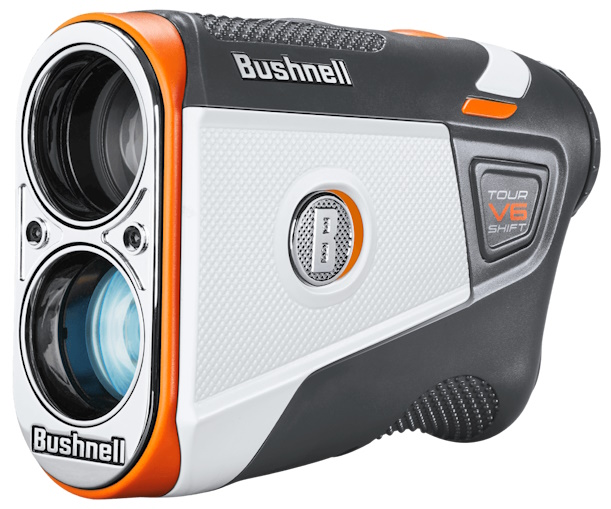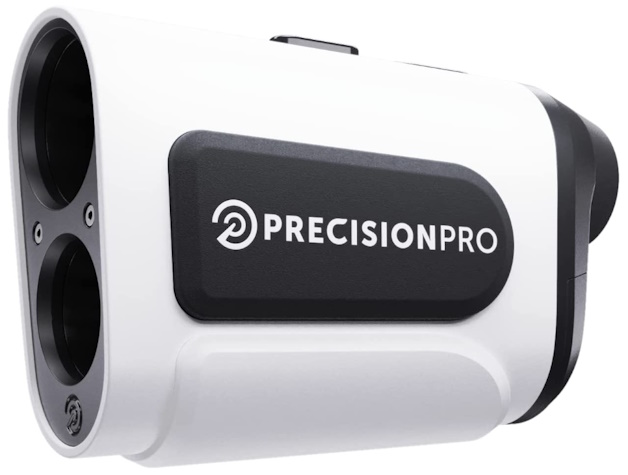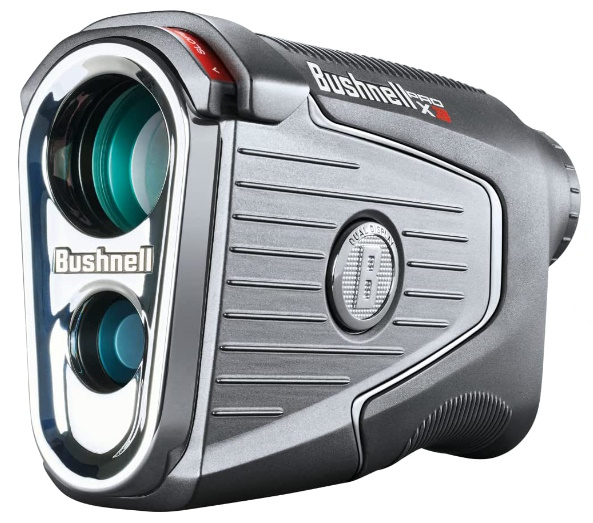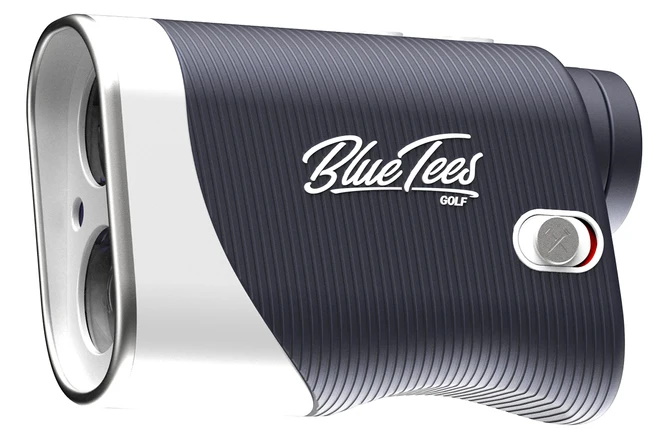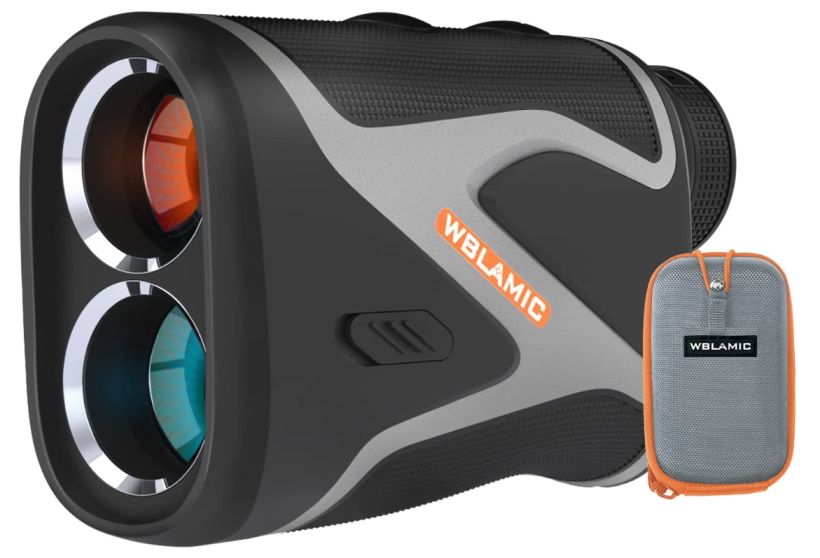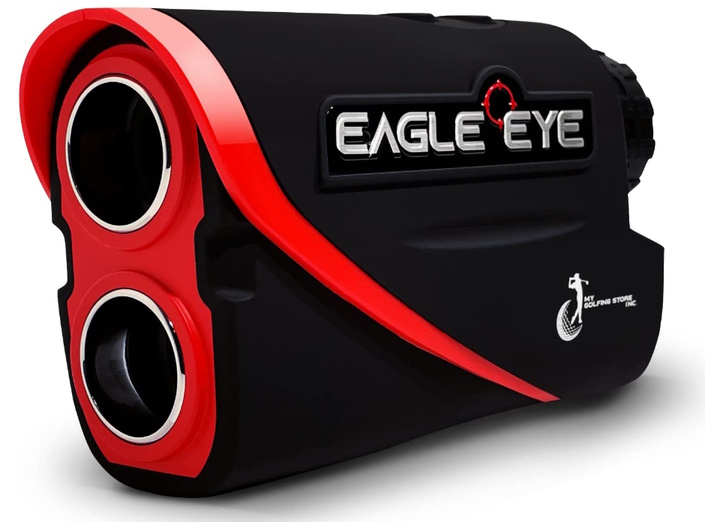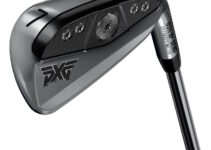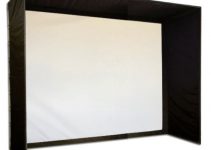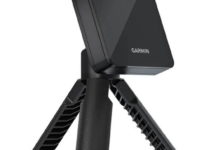Golfstead is reader-supported. When you buy through links on the site, we may earn an affiliate commission at no extra cost to you. Our affiliations include, but are not limited to, the eBay Partner Network and Amazon Associates.
A rangefinder allows you to accurately measure the distance to objects on a golf course such as hazards, greens and pins. This, in turn, enables you to determine the best club to hit and how full of a swing you should take to get your ball as close to the target as possible.
One of the main issues when measuring distances with a rangefinder is elevation change: when the target is at a higher elevation, the arc of the ball flight will be shortened and a longer shot will be necessary, while when the target is at a lower elevation, the arc will be lengthened and a shorter shot will be necessary.
This is why it’s very helpful for a rangefinder to be able to produce slope-adjusted yardages. Fortunately, most quality rangefinders on the market today can do just that.
But because of the large number of options, it can be difficult to figure out which model you should go for.
If you’re looking to buy a rangefinder with slope capability, you’ve come to the right place. In this guide, we’ll review and compare our picks for the best golf rangefinders with slope across a range of different price points.
Note: Golfstead has tested and/or conducted in-depth research into all of the products featured in this guide. Our editorial process for these rankings takes into account a mix of many factors which may include performance, reliability, usability, value for money, cost, and the general consensus from other users of the product. The list that follows may be reassessed or updated over time.
Our Top Picks For Golf Rangefinders With Slope
Based on our own testing, research, and experience, here are our top selections:
- Bushnell Tour V6 Shift Laser Rangefinder
- Precision Pro NX10 Slope Rangefinder
- TecTecTec KLYR Laser Rangefinder
- Bushnell Pro X3 Laser Rangefinder
- Blue Tees Series 3 Max Slope Rangefinder
- WBLAMIC Golf Laser Rangefinder
- MGS Eagle Eye Gen 3 Laser Rangefinder
1. Bushnell Tour V6 Shift Laser Rangefinder
Bushnell has always been known to make quality rangefinders. The Tour V6 Shift, which is the slope version of the Tour V6, offers several improvements over the Tour V5 Shift:
- a more rugged, weather-resistant design
- a sleeker build with updated styling
- brighter and clearer optics
- updated PinSeeker technology
This rangefinder performed exceptionally well during our tests, and the reviews it has received thus far are glowing. It has a modern, quality construction, and the Bushnell brand is trusted by countless pro golfers.
In fact, if you’re willing to spend a few hundred bucks on a quality slope rangefinder that will last, this is one of your best bets.
Features
First, the Tour V6 Shift features an enhanced slope compensation algorithm that accounts for inclines and declines to produce a true “play-as” distance. This can be disabled for tournament play by sliding the Bushnell logo on the side of the unit.
Next, you have the PinSeeker technology, which has been present since the V3 model. This technology is designed to make it as easy as possible to lock onto the pin, with a JOLT vibrating pulse and a flashing red ring. With the V6 model, PinSeeker is more reliable and consistent than ever.
Next is a BITE magnetic cart mount, first introduced with the V5 model. This allows you to easily attach the rangefinder to a cart bar.
The Tour V6 Shift has IPX6 water protection and is the most weather-resistant Tour series rangefinder Bushnell has produced to date.
The Tour V6 Shift also pairs with the Bushnell Golf app. This app provides 3D flyovers, aerial views in full colour, hole layouts, and GPS distances to inform your round even more.
- Weight: 0.54 pounds
- Range: 5-1300 yards
- Magnification: 6x
- Accuracy: Within 1 yard
- Slope Toggle: Yes
Bushnell’s PinSeeker technology is very powerful, but it’s important to know how to use it correctly in order to derive the most benefit from it. Be sure to read the manual well before using.
The Tour V6 Shift is certainly worth getting over previous Tour series models as long as your budget can accommodate it. A non-slope version, called the Tour V6, is also available; this non-slope model is sold in a Patriot Pack that includes a microfiber towel for cleaning the lens and two CR2 batteries.
Pros
- obtains yardages super fast
- magnet is strong
- very high-quality optics
- feels even better than the Tour V5
- premium, sleek look
- accuracy (slope and non-slope) is among the best on the market
Cons
- PinSeeker tech can take some getting used to
2. Precision Pro NX10 Slope Rangefinder
We had previously featured the Precision Pro NX9 rangefinder in this guide, but the NX10 model is a step up and definitely deserves the new spot. It’s currently one of the highest-rated slope rangefinders on the market.
Compared to the NX9, the NX10 has a stronger build, brighter display, faster laser, stronger magnet, and improved targeting. But beyond that, the NX10 has a replaceable skin that, for a small extra charge, can be customized to suit your tastes.
The NX10 Slope is marked by a durable, industrial design, high accuracy, ease of use, and flexible customization.
Features
The Precision Pro NX10 Slope has the same key features that are common with most golf rangefinders rolled out over the last couple years, namely a magnetic cart attachment and pulse vibrations when locking onto the flag.
With the NX10, these features are better than ever. In addition to the reliable Adaptive Slope Technology, its Pulse Vibration Technology ensures that the measured distance on the display is the correct one, and the unit is quick to lock onto targets.
Other features include:
- ability to measure distances to any target
- a custom-designed display
- lifetime free battery replacements
- a carrying case & cleaning cloth included
The skin of the NX10 can be customized with different designs based on American states and cities, sports teams, national flags, and more.
- Weight: 1 pound
- Range: 900 yards
- Magnification: 6x
- Accuracy: Within 1 yard
- Tournament Legality: Legal with Slope Mode turned off
The non-customized version looks pretty bland. However, it’s undoubtedly worth the extra $10 over the NX9.
Pros
- bright, easy-to-read display
- customizable skin is a really nice bonus
- has all the features common to great rangefinders beyond just slope
- premium feel
- great price point
- nice carrying case
Cons
- magnet is rather weak
- a touch on the heavy side
3. TecTecTec KLYR Laser Rangefinder
The KLYR is a brand new laser rangefinder offering by TecTecTec that can accommodate budgets of $200 or less. It’s marked by a modern, pocket-sized design, matte finish, slope capability, and versatile features such as a built-in magnet and belt clip.
The reviews that have come out so far for the KLYR are stellar, earning near-perfect ratings by most critics.
The KLYR is meant to be an upgrade to TecTecTec’s massively popular VPRO500 rangefinder.
Features
The TecTecTec KLYR is compact, coming in at about 30% smaller than the average rangefinder. It has a continuous scan mode for measuring distances to bunkers, hazards, and other points on the course.
The KLYR also has a Target Lock feature, which involves pressing and holding the Power button and slowly moving the aim over the flag from an object behind the flag. The rangefinder will lock onto the flag and display the yardage.
The KLYR’s slope mode compensates for uphill or downhill shots and can be toggled off for legal tournament play.
Another feature of the KLYR is a built-in neodymium magnet that allows for attaching to any metal surface.
- Weight: 1.1 pounds
- Range: 800 yards
- Magnification: 6x
- Accuracy: Within 1 yard
- Slope Toggle: Yes
Included is a special belt clip that works with the KLYR’s magnet, allowing you to wear the rangefinder on your belt for quick access. Also included are a magnetic ball marker, battery, and premium water-resistant case.
Pros
- highly accurate
- fast operation
- stylish
- impressive optics considering the price
- has all the fixings including slope, target lock and magnetic mounting
- compact and comfortable in the hands
Cons
- plastic shell feels a little cheap
- magnet could be stronger
- small exit pupil
4. Bushnell Pro X3 Laser Rangefinder
The Pro X3 is Bushnell’s most advanced laser rangefinder for golf, and boy, is it a powerhouse.
You can think of it as a more powerful, premium, feature-rich version of Bushnell’s Tour V6 Shift. It also replaces the Pro XE and makes a number of improvements over that model.
Features
The Pro X3 has all of the same features as the Tour V6. These are listed in the relevant section and include:
- PinSeeker technology with a JOLT vibrating pulse and flashing red ring
- a BITE magnetic cart mount that allows you to easily attach the rangefinder to a cart bar
- Bushnell Golf app compatibility
When it comes to slope, though, the Pro X3 goes further. It features a togglable Slope with Elements mode, which not only can compensate for elevation changes, but also for temperature and barometric pressure. The elements can be turned off if you just want the standard slope adjustment.
On top of this, you’re able to store elevation data internally in the Pro X3 so that it provides compensated distances for the local course where you play golf most frequently.
The Pro X3 also has an increased magnification of 7x (versus 6x) and an increased maximum range to the flag of 500 yards (versus 400 yards).
Other enhancements include options for a red LED or black display based on preference, an enhanced backlight, an IPX7 waterproof metal housing, and a new locking slope switch that clearly lets you know when you’re in Slope mode.
- Weight: 0.75 pounds
- Range: 5-1300 yards (500 yards to flag)
- Magnification: 7x
- Accuracy: Within 1 yard
- Tournament Legality: Legal with Slope Mode turned off
If you have the budget to accommodate this rangefinder, you’ll be one happy golfer. It’s as simple as that.
Pros
- outstanding durability
- locks onto the target lightning fast
- does everything well
- an ultra-premium experience
- crystal clear display
- powerful features like Slope With Elements enable unprecedented precision
Cons
- very expensive
5. Blue Tees Series 3 Max Slope Rangefinder
The Series 3 Max is Blue Tees’ newest and most advanced rangefinder yet. As the successor to the Series 2 Pro, it promises to “change the way you see the course” with a modern design and next-generation technology.
This rangefinder has gained a lot of steam recently, becoming a best-seller and earning high customer ratings.
Blue Tees’ goal is to make high-quality golf equipment accessible to everyone, and they’ve taken a big step forward with the slope-capable Series 3 Max.
Features
The Series 3 Max has most of the features you would come to expect from a top-quality rangefinder. Similar to the Bushnell Tour V6 Shift and TecTecTec KLYR, it has Flag Lock & Pulse Vibration, which delivers quick vibrating bursts to let you know you’ve locked onto the flag.
The rangefinder also features a new built-in magnetic strip with two magnetic plates. The magnet is very strong and can be used to easily and securely attach the rangefinder to metal surfaces such as on your golf cart.
The Series 3 Max rangefinder is water-resistant. Unlike the Series 2, it has a slope toggle, making it tournament legal.
Another feature unique to the Series 3 Max is an auto-ambient display. This automatically adjusts the colour of the display text to contrast with the environment, making it easy to read at all times.
Enhancing this experience is an ultra-clear display that is an upgrade from the standard HD displays of the previous models.
- Weight: 0.5 pounds
- Range: 900 yards
- Magnification: 7x
- Accuracy: Within 1 yard
- Slope Toggle: Yes
The Series 3 Max Slope comes with a premium leather carrying case, lanyard, mountaineering buckle, and three CR2-3V batteries.
If you don’t care about toggling off slope, you can save a few bucks by getting the previous model Series 2 Pro which has been very successful.
Pros
- impressive speed
- comfortable hold
- highly accurate
- magnet is plenty strong
- superb clarity of optics
- red display is easy to see in different lighting conditions
Cons
- can take a bit of time to lock onto the target
- slope readings can sometimes be a little off
6. WBLAMIC Golf Laser Rangefinder
This rangefinder is a hot new release that costs less than $100 and has been received extremely well. For the price, it boasts an unprecedented amount of power and versatility.
WBLAMIC is a manufacturer of optical products that are used in sports, construction, outdoor exploration, geology, and more.
Features
First off, the WBLAMIC rangefinder has four modes: straight-line distance, flag lock, slope compensation, and speed. They’re pretty self-explanatory, but some of the modes can be used effectively for other applications such as hunting.
The rangefinder has flag lock with pulse vibration (two short vibrating pulses confirm that you have locked onto the target) as well as slope compensation that can be toggled on or off.
One feature that is surprising for a rangefinder priced so low is a built-in magnetic clip, which can securely hold the device to golf clubs or a cart. Other features include:
- high-quality multi-coated optics
- a ±6° adjustable diopter
- a 7° field of view
- yards/meters unit switching
Unlike most other rangefinders that use CR2 batteries, this rangefinder is equipped with a rechargeable 750 mAh Lithium-ion battery. A hard carrying case, cleaning cloth, hand strap, and charging cable are included.
- Weight: <0.73 pounds
- Range: 1100 yards
- Magnification: 6x
- Accuracy: Within 1 yard
- Slope Toggle: Yes
Customers are very pleased with the eyepiece, optics clarity, and light weight. The yardages are generally very accurate, but beyond that, you get many features that are normally limited to $200+ rangefinders.
Pros
- comparable accuracy to the top units
- light yet solidly built
- long battery life
- charges via USB
- customer support is great
- fast operation
- clear viewfinder
Cons
- magnet is not strong enough to withstand large vibrations
- eyepiece focus turns too easily
7. MGS Eagle Eye Gen 3 Laser Rangefinder
My Golfing Store (MGS) is an Illinois-based company that offers rangefinders, training aids, and online coaching programs.
Their Eagle Eye Gen 3 rangefinder is very popular and highly rated; in fact, you’d be hard-pressed to find the performance it delivers at such a good price.
Features
The MGS Eagle Eye Gen 3 sports a clear HD easy-read display and multi-coated optics. It has three modes of operation: continuous scanning, golf, and speed measurement.
The golf mode provides flag locking with vibration and indicates the straight-line distance along with the slope-adjusted distance on the display. Quick target acquisition is enabled by a precise pin sensor.
- Weight: 0.75 pounds
- Range: 800 yards
- Magnification: 6x
- Accuracy: 99.9%
- Tournament Legality: Legal with Slope Mode turned off
The Eagle Eye Gen 3 has a red and black colour scheme. It’s durable, resistant to dust and water, and requires no configuration out of the box — just grab it and start ranging. Included in the package is a microfiber cleaning cloth, battery, strap, and branded carrying pouch.
Pros
- relatively simple and easy to use
- lightweight
- accuracy is comparable to top-of-the-line units
- striking colour scheme
- affordable
- continuous scanning and speed modes are always appreciated
Cons
- no slope toggle
- no magnet for mounting
Buying Guide
There are many rangefinders on the market, and knowing which one to choose isn’t necessarily easy, especially if you don’t know anything about rangefinders. This guide will provide you with the education you need in that regard.
Remember the essential objective of a rangefinder: measuring the distance to the flagstick when hitting your next shot into the green. Also remember that you’re looking for a model with slope functionality. Anything else is greatly appreciated but is merely a bonus.
While it’s nice to hold and feel a rangefinder beforehand, the advantage of shopping for a rangefinder online is that it’s much more convenient to compare specs and technologies for different models.
If you want to find the right golf rangefinder with slope, here are the most important factors to consider:
1. Display

The view through the sight can make or break a rangefinder, and in practice, the quality of the display can vary quite a bit from model to model. In a perfect world, you want:
- clear, bright optics
- a magnification of at least 5x
- a display that is easy to read when contrasted with the background image
- a diopter adjustment to ensure crisp images
Ideally, you want to go for a rangefinder that checks as many of these boxes as possible.
A quality display will help you a great deal in locking onto the flag and locating other landmarks, especially when you’re playing in sunny conditions.
2. Durability
There are a few things to consider when it comes to durability.
First, does the rangefinder come with a carrying case or protective case? If a protective case is available, we recommend using it at all times during your round, and you should also consider putting the unit in its carrying case after each use for maximum protection.
Second, does the rangefinder feel substantial? Super-light rangefinders may sound nice, but they are more prone to wear and tear and also more difficult to keep steady when pointing at targets. We think a weight of 0.5 lbs is a nice sweet spot.
Third, is the rangefinder water or moisture-resistant? Most rangefinders are. If you’re playing in a light drizzle, this will keep your unit safe. Rangefinders can be resistant to dust as well.
Rangefinders usually end up being one of your most heavily used bag items after your golf ball, so it’s important for it to be able to endure years of use.
3. Accuracy

This is really the name of the game when it comes to golf rangefinders. At the end of the day, high accuracy will remove guesswork from your game and improve your club selection.
When you’re measuring the distance to a flagstick, hazard, or any other feature on the golf course, you want the reading to be as accurate as possible. Depending on your skill level, a margin of error of just a couple yards can be the difference between a birdie and a double bogey.
The accuracy to look for in a rangefinder is ±1 yard; we recommend staying away from accuracy ratings worse than this, regardless of your handicap.
Fortunately, most rangefinders made today have accuracies of one yard and sometimes even better than that, which is why this is the third item on our buying guide.
4. Slope Toggle
Given that you’re reading this, you already have a slope rangefinder in mind. Slope adjustment determines the elevation change from your position to the flagstick and generates an adjusted distance reading that takes that slope into account.
Some advanced rangefinders like the Bushnell Pro X3 can compensate not only for slope, but also for environmental factors like temperature and pressure.
But when it comes to rangefinders with slope, one major thing to look out for is whether or not you can toggle off the slope feature. Most modern rangefinders allow you to do this (all the models featured on this page do), but there are still a few out there that don’t.
If slope adjustment can’t be turned off, this means that the rangefinder cannot be used in tournaments where only straight-line distance measurement is allowed.
This is fine if you only play recreationally, but even then, there may be times where it would be better to turn off slope. Hence, in most cases, we only recommend slope rangefinders that have a toggle.
5. Battery Life

It’s also worth taking note of the battery a rangefinder uses. In particular, how long does the battery last on a charge, is it rechargeable, and how many charge cycles is it good for?
Nearly all golf rangefinders these days run on CR2 batteries, which can last 6-12 months, but some rangefinders use rechargeable lithium-ion batteries.
Some CR2 batteries are rechargeable, lasting hundreds of cycles, although regular ones are not very expensive; you might as well buy a pack (get a great deal on Amazon) and keep one in your bag just in case.
Make sure that the rangefinder you’re interested in doesn’t require an unusual type of battery that is overly expensive or difficult to find.
6. Range

Every rangefinder has a range of distances at which it can produce accurate readings. Outside this range, the rangefinder may produce inaccurate readings or no readings at all.
Some rangefinders boast ranges of 1000 yards or more, but while that sounds cool, it’s really not useful in a practical sense and is a bit of a gimmick.
This is because you shouldn’t ever need to measure a distance that is less than how far you can hit your next shot. Unless you’re a long-drive golfer, this shouldn’t be much more than 300 yards.
Almost every rangefinder has a range of at least 400 yards, which will take care of pretty much every situation you’ll face on the course. This is why, while the range of a rangefinder is something to look at, it’s one of the least important factors.
7. Price

Of course, your budget is very important when shopping for a golf rangefinder.
For example, some people don’t want to spend more than $200 on a rangefinder. That’s fine — they have options. And there’s really no reason to get a rangefinder that costs more than $500-$600.
With that said, some rangefinders are cheap for a reason: they may be less accurate, have a cheap construction, have poorer optics, lack flag pulses, lack slope adjustment, have less range or magnification, or something similar.
Slope rangefinders tend to be about $50-$60 more expensive than equivalent non-slope models. In this guide, we’ve tried to include quality slope rangefinders over a range of budgets that golfers might have.
But even for something like a rangefinder, you may be able to access financing for your purchase. Various online golf shops that sell rangefinders also offer financing here, here and here.
Conclusion
Eyeballing it out on the golf course will only get you so far. If you’re serious about developing your distance control and improving your scores, a rangefinder — especially one that can compensate for slope — will be one of the most important accessories in your bag.
A rangefinder can be a huge boon to your golfing toolkit. And finding one that does its job reliably is actually pretty easy if you know what to look for.
Each of the rangefinder models listed above deliver exceptional performance for the cost. We’ve given you the information you need; now it’s up to you to determine which one suits your needs and which one you prefer the most.
It’s also very beneficial to read customer reviews to acquire some useful insights as to how rangefinders actually perform. This will help you a great deal in the decision-making process.
Thanks for reading this guide. Which rangefinder models with slope are you interested in? Do you have any questions? Feel free to leave a comment down below.

